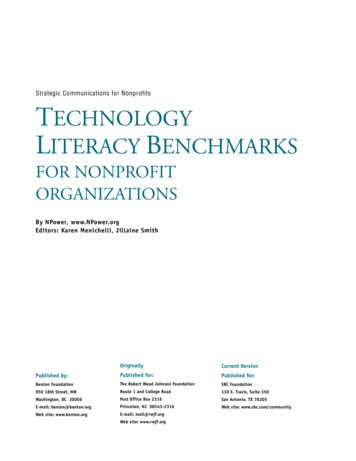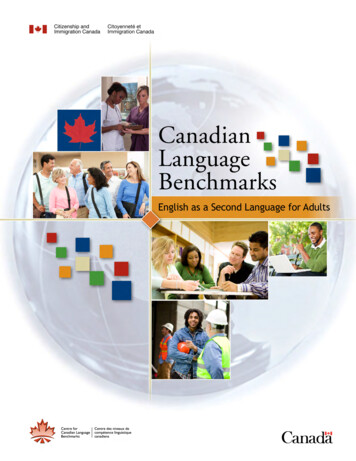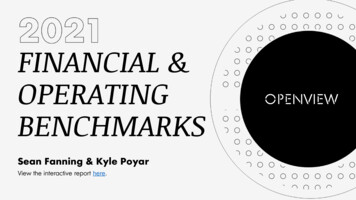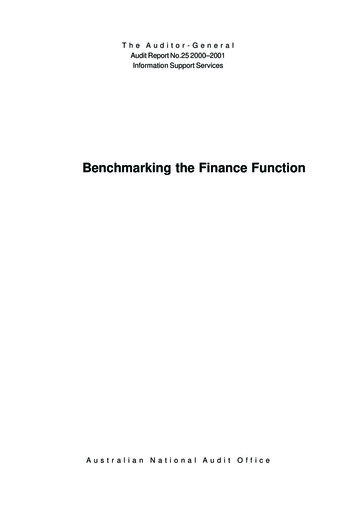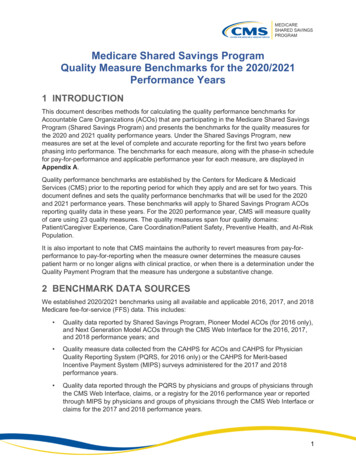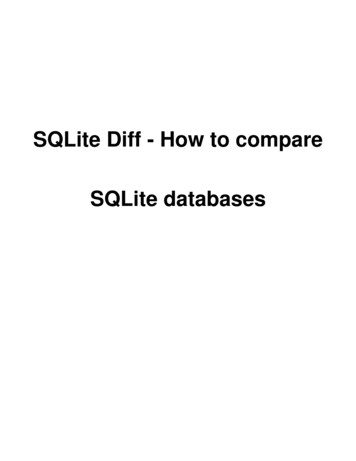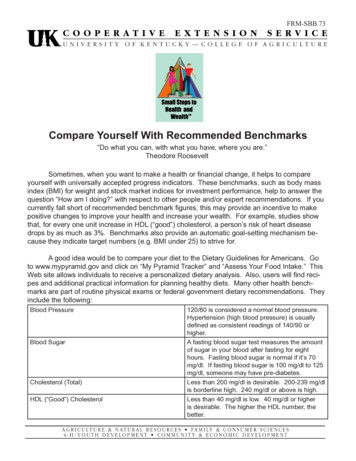
Transcription
FRM-SBB.73Compare Yourself With Recommended Benchmarks“Do what you can, with what you have, where you are.”Theodore RooseveltSometimes, when you want to make a health or financial change, it helps to compareyourself with universally accepted progress indicators. These benchmarks, such as body massindex (BMI) for weight and stock market indices for investment performance, help to answer thequestion “How am I doing?” with respect to other people and/or expert recommendations. If youcurrently fall short of recommended benchmark figures, this may provide an incentive to makepositive changes to improve your health and increase your wealth. For example, studies showthat, for every one unit increase in HDL (“good”) cholesterol, a person’s risk of heart diseasedrops by as much as 3%. Benchmarks also provide an automatic goal-setting mechanism because they indicate target numbers (e.g. BMI under 25) to strive for.A good idea would be to compare your diet to the Dietary Guidelines for Americans. Goto www.mypyramid.gov and click on “My Pyramid Tracker” and “Assess Your Food Intake.” ThisWeb site allows individuals to receive a personalized dietary analysis. Also, users will find recipes and additional practical information for planning healthy diets. Many other health benchmarks are part of routine physical exams or federal government dietary recommendations. Theyinclude the following:Blood PressureBlood SugarCholesterol (Total)HDL (“Good”) Cholesterol120/80 is considered a normal blood pressure.Hypertension (high blood pressure) is usuallydefined as consistent readings of 140/90 orhigher.A fasting blood sugar test measures the amountof sugar in your blood after fasting for eighthours. Fasting blood sugar is normal if it’s 70mg/dl. If fasting blood sugar is 100 mg/dl to 125mg/dl, someone may have pre-diabetes.Less than 200 mg/dl is desirable. 200-239 mg/dlis borderline high. 240 mg/dl or above is high.Less than 40 mg/dl is low. 40 mg/dl or higheris desirable. The higher the HDL number, thebetter.
LDL (“Bad”) CholesterolLess than 130 mg/dl is desirable. 130-159mg/dl is borderline high. 160 mg/dl is highand 190 or above is very high.The 2005 Dietary Guidelines For Americansrecommend eating about 4 ½ cups of fruitsand vegetables a day for someone on a2,000 calorie per day diet.The 2005 Dietary Guidelines For Americansrecommend engaging in at least 30 minutesof moderate intensity physical activity (aboveusual activity) on most days of the week.People who want to lose weight shouldexercise 60 to 90 minutes a day in moderateintensity physical activity.Fruit and Vegetable ConsumptionPhysical ActivityAnother frequently cited health benchmark, body mass index (BMI), is an indicator of bothunderweight and overweight/obesity in adults. It is based on both a person’s height and weight.The formula to calculate BMI is as follows: multiply your weight in pounds by 700. Divide thatnumber by your height in inches. Divide those results by height in inches again. You can alsofind online BMI calculators at government agency Web sites such as www.consumer.gov/weightloss/bmi.htm and www.cdc.gov/nccdphp/dnpa/bmi/calc-bmi.htm.A BMI under 18.5 is considered underweight; from 18.5 to 24.9, normal; from 25 to 29.9,overweight; and 30 and above, obese and morbidly obese (BMI of 40 ). The chart below indicates BMIs for various height/weight combinations. Numbers shaded in green are those in thehealthy range.2
Note that the BMI does not differentiate between fat and muscle, so a person with lots ofmuscle, such as an athlete, may have a BMI in the unhealthy range but still be healthy. Also, theBMI may not be accurate for people who are less than 5 feet tall.With respect to personal finances and wealth-building, there are also a variety of benchmarkindicators to measure progress and weaknesses, including the following:Consumer DebtTo-Income RatioMonthly consumer debt expenses (excluding a mortgage) should not exceed 15% oftake-home pay. This includes payments for credit cards, car loans, and student loans. Adebt-to-income ratio of 20% or more is considered a “danger zone.”Credit ScoreThe higher the number, the better. Credit scores range from the 300s to the 800s withthose in the 720 range considered the best evidence of creditworthiness. People withhigh credit scores generally pay lower interest rates to borrow money than others.Emergency Fund Financial experts generally recommend having access to enough cash to cover house(Liquidity Ratio)hold expenses for three to six months. This money can be a combination of liquid assets(e.g., money market fund) and lines of credit (e.g., home equity line).Expense Ratios Expense ratio is the percentage of fund assets deducted for management and operating(Mutual Funds)expenses. The lower the number, the better; for example .20 (1/5 of 1%) versus 1.5%.High expense ratios are a drag on investment returns and should generally be avoided.Inflation RateSome people use the annual inflation rate (i.e., Consumer Price Index) as a benchmarkand try to have their investments outpace it by a certain percentage.Investment ReInvestment performance is generally tracked against market indices. Indices are portturns on Specific folios of stocks or bonds that are tracked to monitor investment performance over time.SecuritiesSome common indices that are used to measure personal investment performanceagainst include the Standard and Poor’s 500 (U.S. large company stocks), the Russell2000 (U.S. small company stocks), the Wilshire 5000 (all U.S. company stocks), and theMorgan Stanley Capital International EAFE Index (international company stocks). Manyinvestors buy index funds that hold the stocks or bonds that comprise an index. By doingso, they match the market’s performance, minus fund expenses.Net WorthNet worth is calculated by subtracting household debts from household assets. A benchmark for net worth, described in the book The Millionaire Next Door, is calculated bymultiplying age by pretax (gross) income, excluding inheritances, and dividing by ten.This number, or higher, is what your net worth should be. For example, if you are age35 with a 40,000 gross income, 35 x 40 1.4 million, divided by 10 140,000 for anindividual.PersonalizedIndividuals can set benchmarks for their own progress based on their current financialBenchmarksstatus. Examples include saving 10% of gross annual income or increasing net worth annually by 5% (e.g., from 50,000 to 52,500).Retirement Sav- Save 300,000 for every 1,000 of monthly income (to supplement a pension and/or Soingscial Security) needed in retirement. For example, 3,000 of supplemental monthly livingexpenses would require a 900,000 nest egg. This calculation is based upon the maximum 4% withdrawal rate recommended by many researchers. Four percent of 300,000is 12,000 per year or 1,000 per month. Studies have found that a portfolio comprisedof 50% stock and 50% fixed-income and cash assets will last 35 to 40 years with a 4%withdrawal rate.U.S. Household Statistics from federal government databases, such as the Survey of ConsumerFinancial Data Finances and Bureau of the Census data, provide useful financial benchmarks.Average household asset holdings and net worth can all be used for comparisonpurposes. For example, the median net worth of all U.S. households in 2004 was 93,100. Many media sources regularly report household economic data.3
Now it’s time for you to compare yourself to some widely accepted benchmarks. Complete theBenchmark Comparison Worksheet-Health and the Benchmark Comparison Worksheet-Wealth,below:Benchmark Comparison Worksheet-HealthList up to three benchmarks to measure your health status against. Then describe your currenthealth status indicator, your desired health status indicator, and the action necessary to bringyourself in line with the recommended benchmark. Two samples are provided.BenchmarkCurrent Health Status Recommended HealthChangeStatusRequiredBody Mass Index5’5”, 170 pounds5’5”, 140 poundsLose 30 pounds(BMI)BMI of 28 (overweight) BMI of 23 (normal weight) (1-2 pounds/week)Fruit and VegetableEat one cup or less per Eat 2 cups of fruit and 2 ½ Eat about 3Consumptiondaycups of vegetables per day ½ cups more(2000 calorie diet)of fruits andvegetables perdayBenchmark Comparison Worksheet-WealthList up to three benchmarks to measure your financial status against. Then describe your currentfinancial status indicator, your desired financial status indicator, and the action necessary to bringyourself in line with the recommended benchmark. Two samples are provided.BenchmarkCurrent Financial StatusEmergency FundOne month’s expenses( 2,500)Debt-to-IncomeRatioConsumer debt equal to22% of net incomeRecommended Financial Change RequiredStatusThree month’s expenses Save 5,000( 7,500)( 50/week for 2years)Consumer debt noPay off existing debtgreater than 15% of net to lower debt-toincomeincome rati o4
HealthAction Steps Have a comprehensive physical by your doctor and discuss the results of your blood tests. Calculate your body mass index (BMI) to see if you are in a healthy or overweight range. Ifyou are considered overweight, change your eating and activity behavior to work toward ahealthy BMI. Buy a pedometer and work up to walking the recommended 10,000 steps per day.Wealth Take the Rutgers Cooperative Extension Financial Fitness Quiz to assess your overall financial situation at www.rce.rutgers.edu/money/ffquiz.asp. Request your credit score from lenders if you are applying for a car loan, mortgage, or othercredit. Calculate your net worth using the form available at erencesBlood sugar tests: What’s normal? (2004). Retrieved from www.mayoclinic.com/invoke.cfm?id SA00102&si 2279.Body mass index (2000). Retrieved from www.consumer.gov/weightloss/bmi.htm.Johnson, A. (2000). The financial checkup. Providence, UT: Watkins Printing.Milligan, E. (2003). Tips from the top: Targeted advice from America’s top money minds. Indianapolis, IN: Alpha Books.Motivating Americans to develop constructive financial behaviors: A think tank sponsored by theNational Endowment for Financial Education (2004). Financial Counseling & Planning, 15(2),39-49.O’Neill, B. (2002). Twelve components of financial wellness. Journal of Family and ConsumerSciences, 94(4), 53-58.5
Stanley, T.J. & Danko, W.D. (1996). The millionaire next door. New York: Pocket Books.The carewise guide: self-care from head to toe (1996). Seattle, WA: Acamedica Press.2005 Dietary Guidelines for Americans, 2005. Washington DC: Department of Health and HumanServices. Retrieved from du/HEELThe development of the HEEL program was made possible by Senator Mitch McConnell with funds earmarked for the University of Kentucky, College of Agriculture, Lexington,KY and budgeted through the CSREES/USDA Federal Administration.Materials written by:Barbara O’Neill, Ph.D., CFP , Extension Specialist in Financial Resource ManagementKaren Ensle, ED.D., RD, Family and Community Health Sciences EducatorRutgers Cooperative ExtensionSelected for use in Kentucky from O’Neill, B. and Ensle, K./Small Steps to Health and Wealth / (2006). Ithaca, NY:Natural Resource, Agriculture,and Engineering Service.By:Suzanne Badenhop, Ph.D.Extension Professor and Specialist for Family Resource Development.June 2008Copyright 2008 for materials developed by University of Kentucky Cooperative Extension. This publication may be reproduced in portions or itsentirety for educational or nonprofit purposes only. Permitted users shall give credit to the author and include this copyright notice.Educational programs of the Kentucky Cooperative Extension serve all people regardless of race, color, age, sex, religion, disability, or nationalorigin.6
Benchmarks Individuals can set benchmarks for their own progress based on their current financial status. Examples include saving 10% of gross annual income or increasing net worth an-nually by 5% (e.g., from 50,000 to 52,500). Retirement Sav-ings Save 300,000 for every 1,000 of monthly income (to supplement a pension and/or So-

